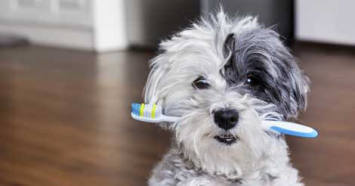
Domesticated pets like dogs and cats need help from their pet parents when it comes to dental care. Animals in the wild rely on natural resources, particularly their prey, to keep teeth and gums healthy. Pets, especially indoor pets, need a bit more help with oral hygiene. This is particularly true for some small breeds like the chorkie, which can be prone to dental issues due to their compact mouths. Brushing your pets' teeth does more than just freshen breath and brighten their smile. It's essential to their overall health.
According to the American Veterinary Medical Association (AVMA), "Periodontal disease is the most common dental conditional in dogs and cats." Unfortunately, periodontal disease doesn't just affect the teeth, mouth, and gums. Over time, it can cause health issues with the animal's heart, liver, and kidneys.
Dental Hygiene for Dogs and Cats
To help reduce the risk for periodontal disease for your dog or cat, practice regular dental hygiene and invest in pet insurance with dental coverage to stay prepared for unforeseen issues. Removing plaque before it can harden into tartar is key. If the plaque does harden into tartar, it "quickly forms small pockets where an animal's gums meet its teeth," states the Veterinary Teaching Hospital at Colorado State University. When this happens, the animal's gums may pull away from the tooth. Bacteria and other particles can deposit into this space, leading to periodontal disease.
What Can I Use to Brush a Dog's Teeth?
A canine toothbrush is recommended by the American Kennel Club (AKC) as the best option for brushing your dog's teeth. It has a curved handle that's long and designed to make it easier to reach all the teeth, even those in the back. You'll also need toothpaste just for dogs.
Safety Tip: Never use human toothpaste to brush your pets' teeth. Always use products designed specifically for dogs or cats. Human toothpaste can be harmful.
How to Brush a Dog's Teeth
Pick a place with good lighting and that's distraction free for both you and your dog. As you begin the process, remember it's important to praise for good behavior throughout the experience. Begin by touching the mouth — lift the upper lip and touch the teeth. Repeat this with the bottom lip. Praise your pup for doing a good job.
Note: In order to properly and safely brush your dog's teeth, he must be comfortable with having his mouth handled. If there's the possibility the dog will bite or otherwise cause you (or himself) harm, do not attempt to brush his teeth until this obstacle is handled. Consider contacting a behavior consultant.
Now that you've let your dog know his mouth and teeth are going to be touched, it's time to move forward.
Introduce the toothbrush by touching it to teeth. Be sure to touch not only the front but the sides and backside. Offer more praise for a good job.
Place a bit of canine toothpaste on your finger and introduce it. Allow him to sniff it and lick it from your finger.
Place the recommended amount (see directions on the toothpaste) on the canine toothbrush.
Lift the upper lip up and begin brushing the front teeth. Offer praise for a good job.
Continue to brush, moving to the side teeth and all the way to the back.
Move back to the front and brush the backsides. Offer praise for a good job.
Hold the bottom lip down and repeat the process but with the lower teeth. Don't forget to offer praise for a good job.
When brushing your dog's teeth, be sure to read his mood at all times. Look for signs of discomfort, pain, or fear. If you see any, stop. This should be a positive experience for your dog, never a traumatic one. Praise and treats for the pup after a job well done.
How to Brush a Cat's Teeth
If you've ever asked, should I brush my cat's teeth? The answer is yes. Cats need teeth brushing just like dogs. Depending on the cat's personality, the endeavor may be a breeze or a task that will take patience and practice. In general, the process for brushing cats' teeth is like a dog's, which makes it easier on the pet parent when you have both in your home. Before each brushing session, gather your supplies. You can find feline toothbrushes at a pet supply store or opt for a feline dental sponge or pad. When using a toothbrush, only use feline toothpaste for your cat's health and safety. Always offer praise throughout the process and a kitty treat when finished.
Choose a quiet place, well-lit with no distractions.
Introduce the toothbrush and the toothpaste or the dental sponge or the pad.
Allow your cat to sniff or lick the chosen dental cleaner to help introduce the taste.
Lift the upper lip and gently brush the teeth and gums in the front.
Work your way to the sides.
Carefully work your way to the back upper molars (tartar likes these teeth).
Note: Most cats won't sit still or allow their human to brush the backside of their teeth. However, every cat is unique. If you think your kitty will let you do it, go for it. Be gentle and alert for cues that your cat is uncomfortable, in pain, or scared. If you sense any of these, stop.
Daily teeth brushing for dogs and cats can reduce the risks for conditions like periodontal disease. Daily brushing in combination with canine or feline dental treats and regular exams by their veterinarian can significantly help with your pets' oral hygiene and overall dental health.